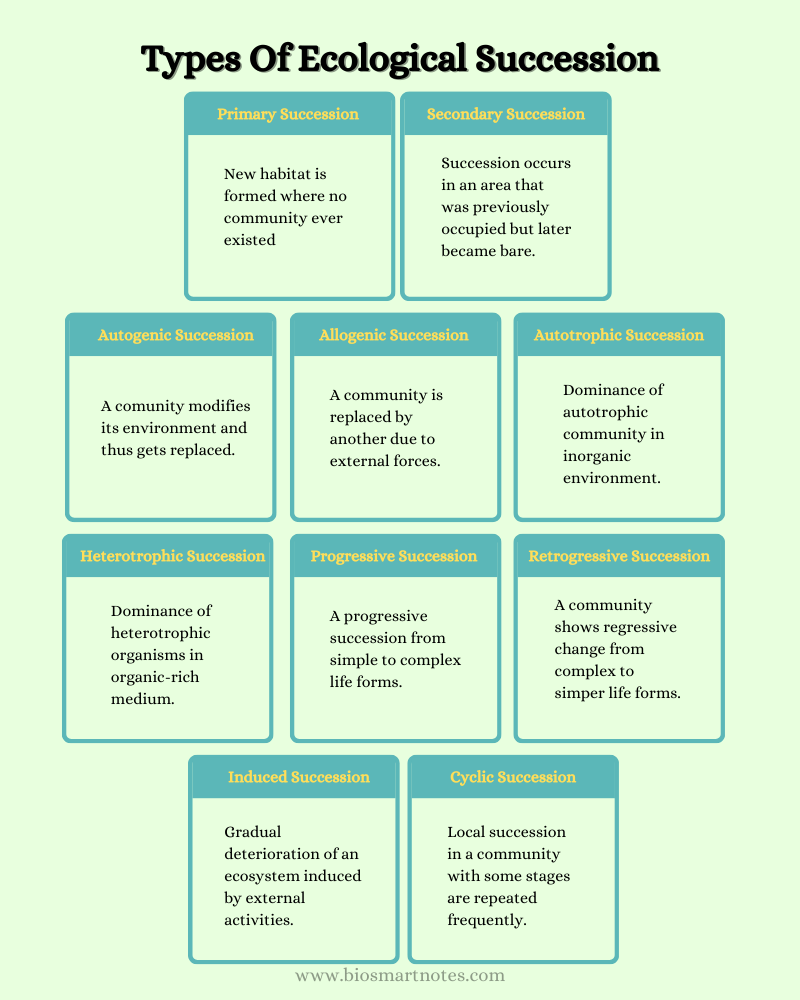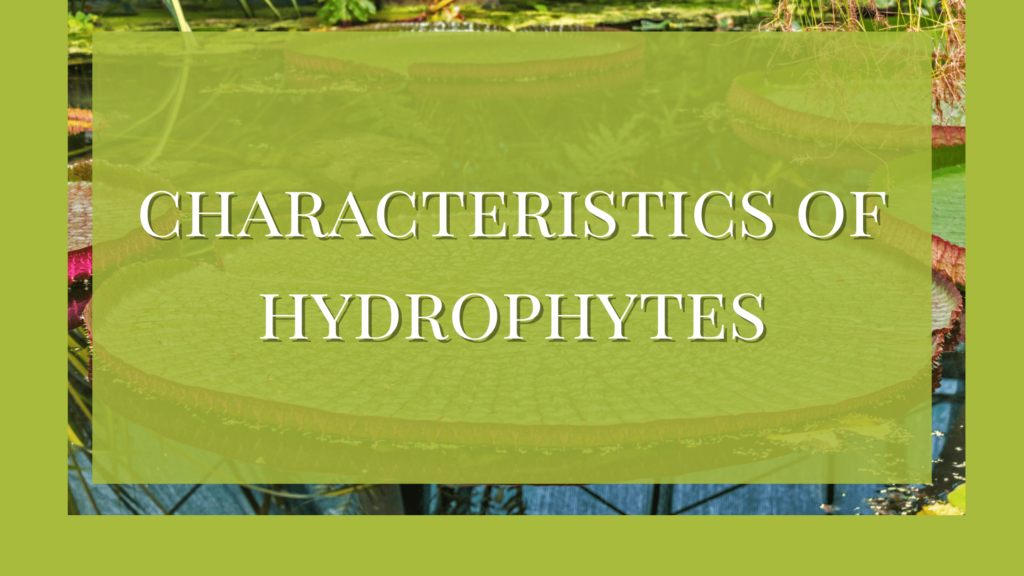Plants are often found in nature to grow as a group. Many plants from the same as well as different species grow in a mutual relationship. This is called a plant community. Ecological succession is the process of natural change in the community structure on an ecological timescale.
In other words, the various types of ecological succession are the natural change in species composition and abundance or the temporal change in the community structure.
In a newly inhabited area, the plant community constantly changes. In other words, the vegetation of a particularly new area changes till the establishment of a stable climax community or forest.
Thus, just as in the case of an individual, vegetation has its own life history. It originates, develops, and matures. This process of evolution of plant communities on bare areas from their birth to the climax stage is called plant succession.
Here, different types of plants are found to grow successively before the establishment of a climax, a stable stage of life. The various intermediary stages in the process are seral communities and together they form a sere.
Ecological Succession Process
Plant succession begins in water habitats such as ponds, lakes, river banks, etc forming a hydrarch and the different stages form the hydrosere.
Likewise, a succession that originates in dry habitats is known as xerarch and its different stages form xerosere.
If a xerosere is noticed on dry rock, it is called a lithosere, and that originating in dry sand is called psammosere. An example of psammosere is a succession that creates a dune ecosystem.
Succession is a community-induced process and the organisms bring forth modifications in the physical environment. These changes in the physical environment determine the pattern and rate of succession within the habitat.
Watch Video
Types Of Ecological Succession
There are two types of plant succession based on the history of the plant where the succession takes place.
Primary Succession
Primary succession is where a new habitat is formed where no community ever existed. If the plant succession proceeds from an extremely bare area with no previous history of vegetation or having no previous inhabitation, it is called primary succession.
Such an area is biologically sterile and will therefore be quite hostile for the first life to evolve and survive. So the succession here will be extremely slow. The perfect example of this type of succession is lithosere.
It may happen as a result of volcanoes, glaciers, etc. Here, the unoccupied space is colonized by pioneers like microbes, mosses, lichens, etc. They must be capable of establishing themselves in the nutrient-poor and unfavorable conditions.
Unwithered rocks usually have colones of Cyanobacteria, bryophytes, lichens, etc. Depositional zones of glacial mountains that are rich in minerals and nutrients usually have herbaceous plants, grasses, etc that grow faster.
Secondary Succession
When the succession takes place at a site that was earlier inhabited by vegetation but became bare due to various reasons or destruction, it is called secondary succession. The destruction could be brought about by natural causes such as fire, floods, volcanic activities, winds, rain, etc, or human activities.
Depending on the magnitude, extent, and frequency of destruction, the disturbance can direct, redirect, or stop the succession process. Thus, the disturbance could be the process that removes the existing vegetation.
This way, secondary succession could be defined as the emergence of biotic communities after the partial or complete destruction of an existing community. Since this was previously inhabited, the area is biologically fertile and hence favorable for the reappearance of life. This type of succession is rather quick when compared to the other one.
A series of communities may arise here subsequently. Moreover, this type of succession is common when compared to primary succession.

Autogenic succession
During succession, a community itself modifies its own environment leading to its replacement with new communities is called autogenic succession. This is a self-generated and self-driven succession process.
It is resulted from the relationship between individuals within their environment. There are no external factors that play here. Instead, it is the organisms that cause changes leading to succession.
Allogenic succession
It is a condition where one community is replaced by another mainly due to forces other than the activities of the communities. This can occur in disturbed ecosystems where nutrients and pollutants come from outside and make changes in the ecosystem.
Autotrophic succession
It is the dominance of autotrophic organisms in predominantly inorganic environments and indefinite energy flow. Here the organic content gradually increases to support and balance the energy flow.
Heterotrophic succession
It is the dominance of heterotrophic organisms such as microbes, in a rich organic medium such as rivers, streams, highly polluted water bodies, small pools with large quantities of litter, etc. Here, there will be more number of fungi and animals than autotrophs.
Progressive Succession
A progressive succession happens from simple life forms to more complex types such as seen from a grassland community to a forest.
Retrogressive succession
This is the return to a less dense, less improvised, and simpler form of the community from a more advanced stage of succession or even from a climax community. In many cases, external forces of natural or manmade activities are the main cause.
Induced succession
Such kind of succession is induced by activities such as overgrazing, shifting cultivation, frequent scraping, industrial pollution, etc that cause gradual deterioration of the ecosystem.
Cyclic succession
It is a local succession happening within a large community where certain stages of succession are repeated whenever there is an open condition available.
Importance of Plant Succession
Plant succession refers to the ecological changes happening to the plant community. It is a slow but regular process that is happening every minute or second.
However, it may take months or years to show any significant changes to be visible. It is important to understand these changes to manage and make use of them. For example, identifying indicator plants and dominating plants are some of the key factors.
The applications of succession to human problems and natural industries are manyfold. They may be illustrated with examples of all the disturbances in vegetation across the globe caused by humans such as fire, clearing of biotic factors, etc.
Plant succession is useful in the rotation of crops and it lies at the root system of management, particularly afforestation and reforestation. It is very important for land classification and hence to regulate grazing and utilisation of public fields of work.
Plant succession is the chief tool in the control of run-off, erosion, and floods, for the conservation of water supplies for irrigation, urban uses in the maintenance of all surface natural resources, etc.
References
- Shukla, R.S. and Chandel, P.S. (2001) Plant Ecology. S. Chand and Company Ltd., New Delhi.
- Verma, P.S., Agarwal, V.K. (1999). Cell Biology Genetics Molecular Biology Evolution and Ecology. New Delhi: S.Chand Co.(Pvt) Ltd.
- https://www.noble.org/regenerative-agriculture/what-is-plant-succession/





Well explained notes especially for someone studying environmental management and technology like myself